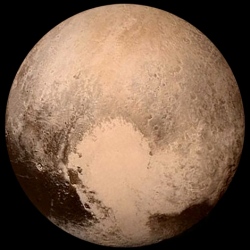
Having traveled from the New Horizons spacecraft over 3.4 billion miles, or 5.5 billion kilometers, the final item, a segment of a Pluto-Charon observation sequence taken by the Ralph/LEISA imager, arrived at mission operations at the Johns Hopkins Applied Physics Laboratory on Oct. 25.
The downlink came via NASA’s Deep Space Network station in Canberra, Australia. It was the last of the 50-plus total gigabits of Pluto system data transmitted to Earth by New Horizons over the past 15 months.
“The Pluto system data that New Horizons collected has amazed us over and over again with the beauty and complexity of Pluto and its system of moons,” said Alan Stern, New Horizons principal investigator from Southwest Research Institute in Boulder, Colorado.
“There’s a great deal of work ahead for us to understand the 400-plus scientific observations that have all been sent to Earth. And that’s exactly what we’re going to do, after all, who knows when the next data from a spacecraft visiting Pluto will be sent?”
Because it had only one shot at its target, New Horizons was designed to gather as much data as it could, as quickly as it could, taking about 100 times more data on close approach to Pluto and its moons than it could have sent home before flying onward. The spacecraft was programmed to send select, high-priority datasets home in the days just before and after close approach, and began returning the vast amount of remaining stored data in September 2015.
A video produced by New Horizons scientists. (See original article) Made from more than 100 New Horizons images taken over six weeks of approach and close flyby, the video offers a “trip” to Pluto. It starts with a distant spacecraft’s view of Pluto and its largest moon, Charon, closing the distance day by day – with a dramatic “landing” on the shoreline of Pluto’s informally named Sputnik Planum.
